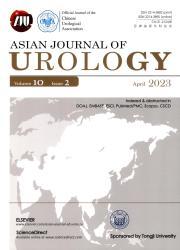Virtual-reality robot-assisted inferior vena cava thrombectomy using virtual vascular endoscopy to identify inferior vena cava invasion
IF 2.4
3区 医学
Q2 UROLOGY & NEPHROLOGY
引用次数: 0
Abstract
Objective
Partial or segmental inferior vena cava (IVC) resection is indicated for tumor control in patients with renal tumors invading the IVC. This study aimed to introduce a virtual vascular endoscope to assist surgeons in locating IVC invasion, formulate a surgical plan for robot-assisted IVC thrombectomy (RA-IVCT), and evaluate its potential value.
Methods
The reconstruction involves building the construction of deep learning models to predict IVC invasion, which were evaluated via intraoperative findings and pathological analysis. Thirty-six patients with renal tumors and IVC thrombi who underwent RA-IVCT between June 2016 and March 2022 were included in the study. A virtual vascular endoscopy was performed based on preoperative CT findings to identify IVC invasion. Based on the extent of IVC wall invasion and the collateral situation, surgeons could decide whether to perform partial or segmental IVC resection during RA-IVCT.
Results
Twenty patients were retrospectively analysed for training in virtual vascular endoscopy (the training cohort), and 16 patients were prospectively analysed to evaluate the accuracy of this technique (the validation cohort). Sixteen patients with IVC invasion underwent cavectomy, whereas six patients underwent partial IVC resection. In the validation cohort, pathological analysis confirmed the exact location of IVC invasion in eight of the nine patients, as indicated by virtual vascular endoscopy. Patients who underwent partial IVC wall resection had less lower extremity edema than those who underwent cavectomy.
Conclusion
Our initial experience showed that the virtual vascular endoscopy could assist surgeons in identifying IVC invasion and creating a surgical plan for RA-IVCT.
虚拟现实机器人辅助下腔静脉血栓切除术,利用虚拟血管内窥镜识别下腔静脉侵入
目的对侵犯下腔静脉的肾肿瘤行下腔静脉部分或节段切除是控制肿瘤的有效方法。本研究旨在引入虚拟血管内窥镜,协助外科医生定位IVC侵犯,制定机器人辅助IVC取栓手术方案(RA-IVCT),并评估其潜在价值。方法构建深度学习模型,通过术中观察和病理分析对模型进行评估。研究纳入了2016年6月至2022年3月期间接受RA-IVCT治疗的36例肾肿瘤和静脉血栓患者。根据术前CT表现行虚拟血管内窥镜检查以确定下腔静脉侵犯。在RA-IVCT中,外科医生可根据下腔静脉壁侵犯程度和侧支情况决定是部分切除还是部分切除。结果回顾性分析20例患者进行虚拟血管内窥镜训练(训练队列),并对16例患者进行前瞻性分析以评估该技术的准确性(验证队列)。16例下腔静脉侵犯患者行腔切除术,6例行部分下腔静脉切除术。在验证队列中,病理分析证实了9例患者中8例的IVC侵袭的确切位置,如虚拟血管内窥镜所示。接受部分下腔静脉壁切除术的患者下肢水肿比接受腔静脉切除术的患者少。结论我们的初步经验表明,虚拟血管内窥镜可以帮助外科医生识别下腔静脉侵犯并制定RA-IVCT手术计划。
本文章由计算机程序翻译,如有差异,请以英文原文为准。
求助全文
约1分钟内获得全文
求助全文
来源期刊

Asian Journal of Urology
UROLOGY & NEPHROLOGY-
CiteScore
4.00
自引率
3.80%
发文量
100
审稿时长
4 weeks
期刊介绍:
Asian Journal of Urology (AJUR), launched in October 2014, is an international peer-reviewed Open Access journal jointly founded by Shanghai Association for Science and Technology (SAST) and Second Military Medical University (SMMU). AJUR aims to build a communication platform for international researchers to effectively share scholarly achievements. It focuses on all specialties of urology both scientifically and clinically, with article types widely covering editorials, opinions, perspectives, reviews and mini-reviews, original articles, cases reports, rapid communications, and letters, etc. Fields of particular interest to the journal including, but not limited to: • Surgical oncology • Endourology • Calculi • Female urology • Erectile dysfunction • Infertility • Pediatric urology • Renal transplantation • Reconstructive surgery • Radiology • Pathology • Neurourology.
 求助内容:
求助内容: 应助结果提醒方式:
应助结果提醒方式:


